Should I Visit an Urgent Care Center or an Emergency Room?
You may recall a time in your life where you woke up in the morning with a sore throat. You couldn’t afford to take time off work, so you forced yourself to make it through the day. After work, your symptoms got worse. You developed a fever and felt run-down. Your primary doctor’s office was already closed, and you wondered if you should go to an urgent care center or stay home. Part of you was worried you had a serious illness that might require emergency care.
Or, perhaps there was a time when you stubbed your big toe on an end table. You were pretty sure you had broken your toe, but you weren’t sure if you needed medical attention right away, or at all.
Sometimes it can be difficult to tell if an illness or injury requires a trip to the emergency room. You may not live close to an ER or have the funds to cover the cost of hospital medical bills. How do know if your injury requires emergency care, or if an urgent care clinic would suffice?

Lots of Americans visit the emergency room every year, and often unnecessarily. In 2014, 141.4 million Americans went to the emergency room, 1.8 million were admitted to critical care and 7.9 percent of the visits resulted in hospital admission, according to the Centers for Disease Control and Prevention (CDC). At least30 percent of emergency department visits in the U.S. are non-urgent.
As you’ll see, it is not always necessary to rush to an emergency room after an injury or while experiencing illness. However, sometimes a trip to the ER is a smart move, and it’s important to know the difference.
To help you determine if an illness or injury requires emergency medical attention, we will look at the signs of a serious medical condition or injury. We will also explore the differences between urgent care centers and emergency rooms regarding cost and wait times to help you figure out if an ER trip is ultimately worth the time and money.
What’s the Difference Between an Urgent Care Center and an Emergency Room?
The idea of urgent care centers came to fruition in the 1970s when physicians began opening practices to suit patients with non-emergency, but pressing medical matters. Critical care practices allowed patients to seek medical care outside of regular doctor’s office hours. There are currently more than 7500 urgent care centers in the United States.
Emergency care is a bit older than urgent care. While there have been methods to provide emergency care since the earliest days of medicine, emergency medicine did not become a specialty until the 1960s. Before the 60s, emergency care patients were seen by whoever was available. This means someone who needed to meet with a specialist would have been seen by any physician regardless of their medical background.
Developments in medical knowledge and technology helped medical professionals recognize a need for specialized emergency care. In 2012 there were 3930 emergency departments in the U.S., and in 2017 there were 34,816 emergency physicians certified by the American Board of Emergency Medicine (ABEM).
In general, if your injury or illness is not life-threatening, you can save time and money by visiting an urgent care center. However, if you’re experiencing symptoms of a life-threatening condition like a stroke or heart attack, you do not want to waste any time. Call 911 or head straight to the nearest emergency room. In general, these two facilities differ for three significant reasons: services, wait times and cost.
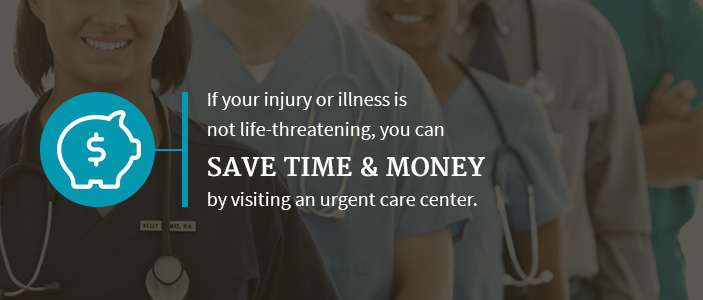
1. Urgent Care Services vs. ER
An urgent care center is a medical facility that usually offers evening and weekend hours. Many patients visit an urgent care clinic for convenience, and appointments are not necessary. Some may stop in at an urgent care clinic if their regular family doctor is not available. Urgent care is an excellent option for patients who need non-emergency medical attention outside of their regular physician’s office hours.
At an urgent care center, services are provided under the direction of an allopathic or osteopathic physician. Both allopathic and osteopathic physicians are fully trained in diagnosing and treating illnesses and disorders. Both can also prescribe medication, perform surgery and practice specialties. However, osteopathic doctors receive specialized training in areas such as osteopathic manipulative treatment (OMT), and they may emphasize preventive care.
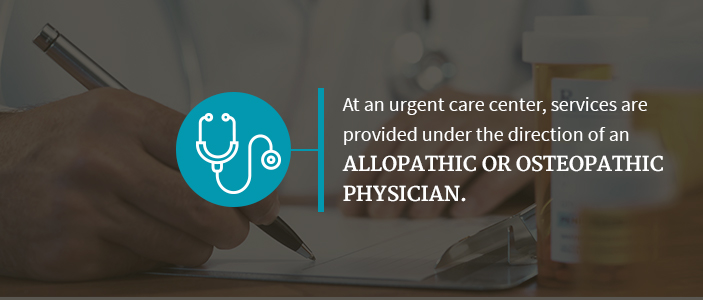
How do you know if you should go to an urgent care center or wait to see your regular doctor? If you need immediate treatment for an illness or injury that is not life-threatening, you should consider visiting your nearest urgent care center. Most urgent care centers are open seven days a week, including holidays, between 8 a.m. and 9 p.m. Some centers may close earlier on weekends, however.
Whether you need to visit an urgent care center depends on your symptoms and the severity of your condition. Here are common illnesses and injuries that likely do not require an ER visit, but should be treated by a physician, as they could lead to complications if left untreated:
- Flu, cold or allergy symptoms
- Ear, eye or sinus infections or pain
- Insect bites
- Bronchitis
- Sprains or broken bones of the wrist, hand, ankle or foot
- A sore throat
- Minor cuts or burns
- Vomiting
- Diarrhea
- Nausea
- Asthma
- Minor back pain
- Urinary tract infections
- Minor allergic reactions
- A slight headache
- Any infection
Services commonly offered by urgent care centers include:
- X-rays
- Simple lab tests
- Stitching for minor cuts
- Treatments for infections, cold and flu
- Casting
- Physicals
- Employment drug-testing
- Pain management medication
- Vaccinations
If you or your loved one are experiencing life-threatening symptoms or have been in an accident, do not waste time going to an urgent care center. Instead, call 911 and get to an emergency room immediately. Unlike urgent care centers, emergency departments have almost everything they need to diagnose and treat any illness or injury. The job of an emergency department is to save lives.
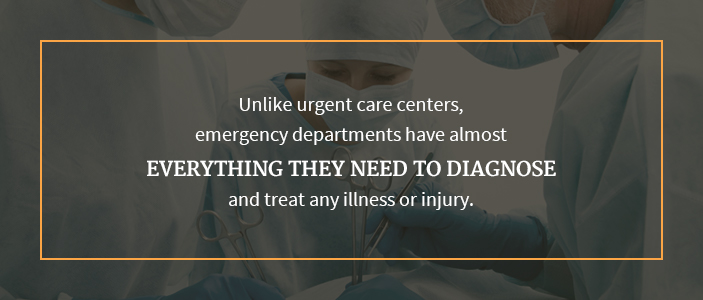
Emergency rooms are open 24 hours a day, seven days a week. It is a smart idea to go to the emergency room if you are experiencing any of the following:
- High fever that medicine cannot bring down
- Injury to neck or spine
- Poisoning
- Head injury
- Major burns
- Heart attack
- Seizures
- Stroke
- Broken bones that have punctured the skin
- Paralysis
- Severe pain anywhere in the body
- Any severe injury
- Unconsciousness
- Deep wounds
- Coughing or vomiting blood
- Major allergic reactions
- Uncontrollable vomiting or diarrhea
- Drug or alcohol overdose
- Suicidal thoughts
- Electrical shock
- Bleeding that will not stop
In the ER, you can expect access to the following diagnostic tools and treatments, some of which are not available in urgent care clinics or your primary doctor’s office:
- MRIs
- CT scans
- Operating rooms
- Ultrasounds
- Labwork
- X-rays
- Treatments and medication
- Orthopedic equipment
- Cardiac monitoring
- Anesthesia
Depending on your health concern and treatment procedure, you might also have to stay overnight in a hospital — you likely will not find beds in an urgent care clinic. Many emergency departments also have physicians with various backgrounds and specialties on-staff at all times, unlike urgent care centers.
Of course, there is always an exception to the rules. Some patients may visit an ER in the middle of the night when urgent care centers are closed even if they are not experiencing severe symptoms. Although you are free to visit the emergency room whenever you wish, realize emergency room visits are very costly, and your insurance may not cover the care you receive — especially if it is not an actual emergency. If you are uncertain about what to do, never hesitate to call your healthcare provider and ask questions.
2. Urgent Care Wait Times vs. ER
Wait times in emergency rooms and urgent care centers can vary greatly depending on many circumstances. Generally, if you go to an urgent care center, you will be seen quicker than if you went to an emergency room. According to a 2015 survey conducted by the Urgent Care Association of America, the average urgent care wait time is 30 minutes or less, and most patients were treated in 60 minutes or less.
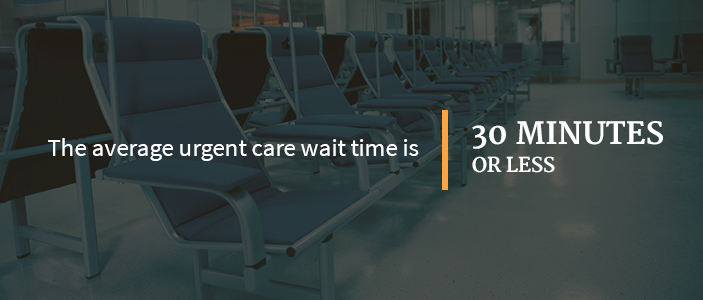
On the contrary, emergency rooms take care of patients with the most life-threatening conditions first. So, if you go to the ER with only a sore throat, it may be a long time before you are back home in bed.
When a patient arrives in the ER, a triage nurse evaluates the severity of their condition. Those who are severely ill or injured are the priority in an emergency room, and patients with mild or minor ailments are left to wait.Treatment times are also longer for patients in emergency rooms. According to the CDC,thefive triage levels are as follows:
- Immediate
- Emergent
- Urgent
- Semi-urgent
- Nonurgent
The CDC also reported the time difference for different triage levels. For example, those considered to be in need of immediate care were to be seen in less than a minute, whereas as semi-urgent patients were triaged as needing to be seen within one to two hours. Nonurgent patients were triaged to be seen between two and 24 hours — thus one of the reasons to avoid the ER for the common cold.
Between 2010 and 2011, the average wait time in the emergency room was 30 minutes, and treatment time was 90 minutes or longer. For those in need of immediate attention, the median wait time was 12 minutes. However, if your condition would worsen while waiting in the ER, do not hesitate to speak to the hospital staff and let your situation be known.
Where you live affects wait times, too. In 2009, the CDC found that the average wait time in urban areas was 62.4 minutes. Outside of metropolitan areas, the average wait time was 40 minutes.

As you can see, if your illness or injury is not life-threatening, you could save a lot of time by visiting an urgent care clinic instead of going to the ER. However, sometimes unfortunate events happen, and your health is not something you ever want to risk. If you have any doubt in your mind about the severity of your or your loved one’s condition, it might be best to play it safe and head to the ER. If there’s time, you can also call a nurse and ask for a professional opinion.
3. Urgent Care Cost vs. ER
An emergency room visit is considerably more expensive than a trip to an urgent care center. Most urgent care centers accept insurance and cost around the same as a visit to a primary care doctor. The average price for a trip to an urgent care center is around $150. By contrast, the average cost for an emergency room visit ranges from $300 to $500. Depending on your condition, emergency room medical bills can easily surpass $1000.

A study published in 2013 found that out of 76.6 million emergency department visits, charges for an upper respiratory infection ranged from $740 to $3347. The median expense for all standard conditions such as sprains, back problems and urinary tract infections was $1233 in the ER.
Consider how Medica, a health plan company, calculated costs based on claims made to the Medica Choice Network. Here are the differences they found between urgent care centers and emergency rooms:
- Allergies: $200 for urgent care and $733 in the ER
- Acute Bronchitis:$242 for urgent care and $1074 in the ER
- Earache: $229 for urgent care and $779 in the ER
- Pink Eye:$184 for urgent care and $621 in the ER
- Strep Throat:$231 for urgent care and $1043 in the ER
Many non-life-threatening illnesses, like an upper respiratory infection, for example, can be treated at an urgent care center. Why pay for emergency care if you don’t need it? However, if you are struggling to breathe, you may need emergency attention. Theurgent care center staff will send you to the emergency room if needed.
The downside to going to an urgent care center first when you should be going to the ER is that you lose precious time between trips. Sometimes, depending on the severity of an illness or injury, time is far more important than money.
Why are emergency rooms so expensive? It is the price a patient pays for 24/7 care and emergency equipment on-hand.Also, depending on your insurance plan, a trip to the ER may or may not be covered entirely — another reason to weigh the pros and cons in non-life-threatening situations.
How Do You Know When to Go to the ER?
We covered a lot of factors to consider when deciding whether you should go to an urgent care center or an emergency room. Keep in mind that if you or a loved one are experiencing life-threatening symptoms, you should not hesitate to get emergency medical attention immediately.
Some symptoms, like prolonged vomiting, might not seem like a life-threatening symptom but could lead to serious complications, like dehydration. Know what to look out for and when to recognize a medical emergency. Signs of a medical emergency include:
- Uncontrollable bleeding
- Difficulty breathing
- Chest pain
- Choking
- Coughing or vomiting blood
- Loss of consciousness
- Sudden severe pain
- Severe vomiting
- A broken bone that pierces through the skin
The following conditions are common causes of death or health complications and require immediate attention. If you suspect any of the following, do not wait and get to an ER:
- Heart Attack:About 735,000 Americans suffer a heart attack every year, according to the CDC. With a heart attack, it’s important not to ignore the early warning signs of chest pain or discomfort, pain in the arms, jaw or back, shortness of breath, cold sweats and nausea. Although you can experience chest pain for various other reasons, consider the risk factors. If you have high blood pressure, high cholesterol and if you smoke, you don’t want to take a chance with chest pain.
- Stroke:More than 795,000 Americans have a stroke every year. High blood pressure, high cholesterol, diabetes, obesity and smoking are the leading risk factors. The primary signs of a stroke include numbness in the face or limbs, sudden confusion or trouble speaking, sudden severe headache, and difficulty seeing and walking.
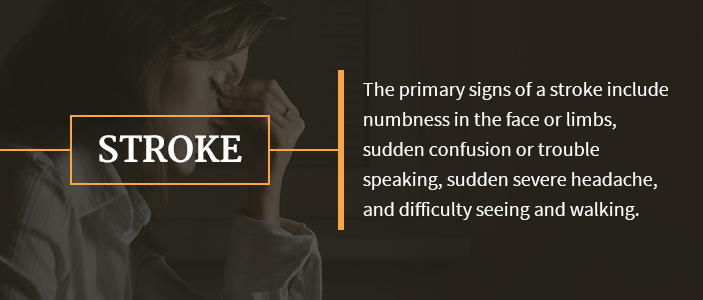
- Dehydration:Mostly a concern for young children and the elderly, dehydration can occur if a person cannot keep down fluids or has had severe diarrhea or vomiting for hours. Dehydration requires immediate attention because fluids are needed for your body to carry out routine functions. Symptoms in young children include dry mouth and no tears when crying. Adults may experience dark-colored urine, fatigue, confusion and extreme thirst. Remember, dehydration can happen to anyone.
- Severe Head Injury:Loss of consciousness, persistent headaches or a headache that worsens, repeated vomiting or nausea, convulsions, loss of coordination, inability to wake from sleep, slurred speech and severe confusion are all symptoms of a traumatic brain injury. Brain injuries may result from a fall, car accident, violence or a sports injury. A severe injury could lead to a coma or brain death, so it’s vital to get emergency care.
Still not sure when to go to the ER? Ask yourself if your condition is fatal. If the answer is yes, go to the ER. If your situation is not severe enough to warrant immediate medical attention but still requires prompt care, visit an urgent care clinic. If your condition is mild enough to wait a day or two, schedule an appointment with your primary care doctor. Your primary care doctor has your medical information on file and will keep a record of your visits, unlike an urgent care center.
Walk-Ins Welcome at OIP
If you live in central Pennsylvania and have experienced an orthopedic injury such a strain, sprain, fracture or dislocation, stop in at the Orthopedic Institute of Pennsylvania (OIP) today. There is no need to take your orthopedic injury to the ER when you can go to OIP and receive the highest-quality emergency orthopedic care.
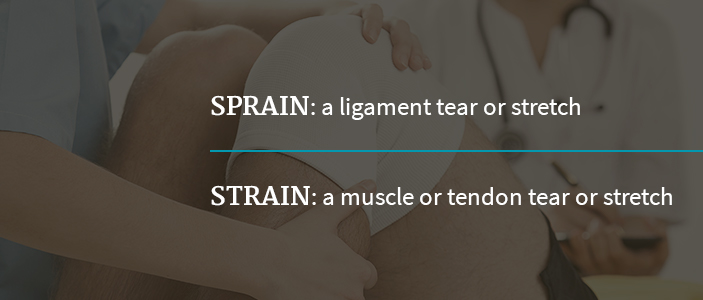
As the region’s first orthopedic injury clinic, we are here to help you — no appointment needed. Our knowledgeable, compassionate team is ready to diagnose and treat your injury, saving you the time and expense of going to the ER. At OIP you can expect:
- A shorter wait time than the ER
- A visit with an orthopedic specialist if needed
- Typically lower copays than the ER
- Comprehensive care on-site from X-ray diagnostics to cast application
- Lowest-cost orthopedic emergency care in central PA
We commonly treat:
- Hamstring pulls
- Ligament injuries
- Tailbone injuries
- Shoulder or knee dislocation
- Fractures or broken bones
How do you know what type of injury you have? First, let’s look at strains and sprains.
A sprain is a ligament tear or stretch, and a strain is a muscle or tendon tear or stretch. Ligaments connect bones to bones at the joints, while tendons connect bones to muscle.A sprain might occur when a person twists or falls— ankle sprains are the most common type.
Strains are commonly experienced by athletes who do the same motion repetitively like lifting weights or playing tennis. Both sprains and strains show the following symptoms:
- Inflammation
- Pain
- Bruising
Broken bones or fractures occur when too much force is applied to them. Car accidents or hard hits by any object can cause a broken bone. Broken bones are very painful and include symptoms such as:
- Swelling or bruising over the bone
- Deformity
- Pain that gets worse when moved or pressure is applied
- Inability to use the fractured area
A dislocated shoulder or knee may result from a sports injury, fall or accident and is when the bone pops out of the joint. You might experience:
- Visible deformity
- Swelling or bruising
- Severe pain
- Inability to move the dislocated area
Visit or Contact OIP for Your Orthopedic Injury

If you suffered an orthopedic injury, do not hesitate to reach out to OIP for immediate care. We participate with many conventional healthcare providers and accept various payment methods to ensure exceptional care is within your reach. We have three urgent care locations in the Harrisburg region to make urgent orthopedic care as convenient for our central PA patients as possible.
With a longstanding reputation for excellence and a healthcare team who cares, our patients know they can depend on us for the help they need. Contact OIP today for more information, or stop in at one of our locations for urgent assistance. Need orthopedic advice beyond office hours? Call 855-OUCH-OIP.







